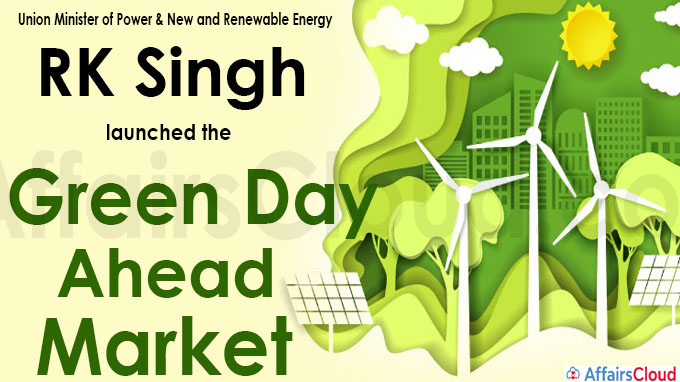 On October 25, 2021, the Union Minister of Power & New and Renewable Energy, R K Singh launched India’s 1st ‘Green Day Ahead Market’ (GDAM) for the renewable energy (RE) to enable the electricity generation and distribution companies (Discoms) to trade (i.e. buy or sell) RE in the day-ahead market.
On October 25, 2021, the Union Minister of Power & New and Renewable Energy, R K Singh launched India’s 1st ‘Green Day Ahead Market’ (GDAM) for the renewable energy (RE) to enable the electricity generation and distribution companies (Discoms) to trade (i.e. buy or sell) RE in the day-ahead market.
- India is the only large electricity market in the world to implement a GDAM exclusively for RE.
- Objective: To reduce the dependency on imported sources of fossil fuel.
- Nodal Agency: National Load Despatch Centre (NLDC), Power System Operation Corporation Limited (POSOCO), is the Nodal Agency of GDAM and it has set up the latest technologies and communication infrastructure for facilitating GDAM.
What is the Day-Ahead Market?
i.The power trading market currently has two platforms in India viz, Power Exchange India Limited (PXIL) and India Energy Exchange (IEX). These exchanges have several power trading mechanisms such as term ahead, green term ahead, day-ahead, intraday and real-time market.
- In which, the Day-ahead market facilitates the trading of power a day before.
ii.Under trading, Sellers are represented as the power generating stations and the buyers include power Discoms, industrials, and commercial consumers.
Note – IEX holds 95 percent of the day-ahead spot power trading segment, whereas PXIL holds 40 percent market share in the term-ahead market and RE Certificates (RECs).
Key Features of GDAM:
i.GDAM will provide competitive price signals and provide opportunities for the green market participants to trade in green energy, in a transparent, and efficient manner.
ii.The market-based competitive prices will enable the RE generators to sell power and also increase the renewable capacity.
iii.Benefits of GDAM:
- The domino effect: GDAM will lead to a gradual shift from the Power Purchase Agreements (PPAs)-based contracts to market-based models, which will, in turn, build and deepen the energy markets to the next level and support India to meet the ambitious target of 450 GW green capacity by 2030.
- Participating in the GDAM will reduce the curtailment of green power and unlock the not yet used RE potential. It also ensures instant payment to RE generators (i.e. on the same day of delivery).
- GDAM will have the advantages of free Inter-State Transmission (ISTS) and Open access (yet to be granted).
iv.Selling and Buying:
- The distribution utilities could sell surplus renewable power generated in their area through GDAM.
- Whereas the obligated entities could meet the Renewable Purchase Obligation (RPO) target by directly buying green power from the power exchanges.
- The non-obligated entities also could buy power on a voluntary basis (to increase the share of green power).
v.Bidding &Clearance:
- The GDAM will operate in an integrated way with the conventional day-ahead market.
- The Indian Energy Exchange (IEX) will offer the market participants to submit bids together for both conventional and RE through the separate bidding windows.
- The RE bids will be cleared first followed by the conventional segment. Separate price discoveries will be followed for both conventional and REs.
Additional Info:
Coal dues:
- All the states and power Discoms have not paid around Rs 16,000 crore to Coal India.
- The dues of all central power gencos (generating companies) (excluding states owned) have increased to Rs 75,000 crore due to the nonpayment of the states and Discoms for the power used.
Recent Related News:
India with a score of 66.2 has been ranked 3rd out of 40 countries in the 57th Renewable Energy Country Attractiveness Index (RECAI) – May 2021 – released by Ernst & Young Global Ltd (EY). The United States (US) topped the index, while China took the 2nd Rank.
About Ministry of New and Renewable Energy (MNRE):
Union Minister – Raj Kumar Singh (Constituency – Arrah, Bihar)
Minister of State – Bhagwanth Khuba (Constituency – Bidar, Karnataka)




